VI. The External Economy - ആർബിഐ - Reserve Bank of India
VI. The External Economy
Balance of payments (BoP) developments during the first quarter of 2005-06 point to a sharp turnaround in the current account balance, due to a widening of the merchandise trade deficit. Nonetheless, with capital flows remaining strong -led by foreign investment flows, direct as well as portfolio - and in excess of the current account deficit, the balance of payments position remained comfortable and the overall balance recorded a modest surplus. External debt recorded a modest decline during the quarter ended June 2005. Foreign exchange reserves have increased by US $ 1.9 billion in the current fiscal year so far to US $ 143.4 billion as on October 14, 2005. Various reserve adequacy indicators show that the current level of foreign exchange reserves is adequate.
International Developments
Despite record high international crude oil prices, global GDP growth has exhibited a considerable degree of resilience during 2005 so far. According to the International Monetary Fund (IMF), global economic activity is projected to grow by 4.3 per cent in 2005 on top of 5.1 per cent growth recorded in 2004 - which was a three-decade high - buoyed by strong corporate performance, accommodative macro policies and favourable financial market conditions. Following a temporary slowdown in mid-2004, global GDP growth picked up in the first quarter of 2005 benefiting from robust services sector which offset deceleration in manufacturing and trade. In the second quarter of 2005, record high oil prices exerted a drag on growth with leading indicators turning downward and business confidence weakening in major countries.
Growth divergence across regions, however, remains wide and growth continues to be led by the US and China (Table 40). Concomitantly, global current account imbalances have further accentuated with the US current account now projected to increase from 5.7 per cent of GDP in 2004 to 6.1 per cent in 2005 and stay at that level in 2006. Growth in Euro area remained subdued as the recovery in domestic demand that set in during the second half of 2004 has slowed down considerably. After gaining momentum in the first quarter of 2005, domestic demand in Japanese economy recovered further in the second quarter of 2005 on the back of a strengthening private consumption and business investment supported by improvements in labour market, high corporate profitability and improvement in business expectations.
As regards prospects for 2006, global GDP growth is projected by the IMF at 4.3 per cent, the same as in 2005, benefiting from still accommodative macroeconomic policies, and benign financial market conditions. However, high international crude oil prices, increasing protectionist sentiment, and widening global imbalances pose serious downside risks to growth prospects.
Global inflationary pressures, after remaining relatively contained during the first half of 2005, have witnessed some pick up in recent months. The main
Table 40: Growth Rates
|
(Per cent) |
||||||
|
Country |
2004 |
2004-Q2 |
2004-Q3 |
2004-Q4 |
2005-Q1 |
2005-Q2 |
|
1 |
2 |
3 |
4 |
5 |
6 |
7 |
|
Advanced Economies |
||||||
|
US |
4.4 |
4.6 |
3.8 |
3.8 |
3.6 |
3.6 |
|
UK |
3.1 |
3.7 |
2.1 |
2.9 |
2.1 |
1.5 |
|
Euro Area |
2.1 |
2.2 |
1.8 |
1.5 |
1.4 |
1.1 |
|
Japan |
1.9 |
3.2 |
2.6 |
0.6 |
1.3 |
1.4 |
|
OECD Countries |
3.3 |
3.7 |
3.2 |
2.8 |
2.6 |
2.6 |
|
Emerging Economies |
||||||
|
China |
9.5 |
9.6 |
9.1 |
9.5 |
9.4 |
9.5 |
|
Malaysia |
7.1 |
8.0 |
6.8 |
5.6 |
5.7 |
4.1 |
|
Indonesia |
5.1 |
4.3 |
5.0 |
6.7 |
6.4 |
5.5 |
|
South Korea |
4.6 |
5.5 |
4.7 |
3.3 |
2.7 |
3.3 |
|
Thailand |
6.9 |
6.4 |
6.1 |
5.1 |
3.3 |
4.4 |
|
Brazil |
5.2 |
4.7 |
5.3 |
4.2 |
2.6 |
3.9 |
|
Argentina |
9.0 |
7.1 |
8.7 |
9.1 |
8.0 |
10.1 |
|
India |
6.9@ |
7.6 |
6.7 |
6.4 |
7.0 |
8.1 |
|
@: FY 2004-05. Sources: The Economist and the OECD. |
||||||
risks to global inflation outlook continue to be high international oil prices and persistent global imbalances between the US and the main regions of the world.
Growth in world trade during 2005 so far has remained strong although there was some loss of momentum from a year ago (Table 41). The world export growth of 14.3 per cent in US $ terms during January-May 2005 was underpinned by a volume growth of 5.7 per cent. The prices of non-oil primary commodities witnessed an increase of 8.0 per cent during January-May 2005 as compared with an increase of about 21.6 per cent during the corresponding period of the previous year.
Table 41: Growth in Merchandise Exports: Global Scenario
|
(Per cent) |
|||
|
Region/Country |
2004 |
2004 |
2005 |
|
(January-May) |
|||
|
1 |
2 |
3 |
4 |
|
World |
21.2 |
20.2 |
14.3 |
|
Industrial Countries* |
17.4 |
17.8 |
9.7 |
|
USA* |
12.9 |
13.2 |
10.3 |
|
Germany* |
21.3 |
22.3 |
9.2 |
|
Japan* |
19.9 |
23.2 |
5.6 |
|
Developing Countries |
27.2 |
24.5 |
19.1 |
|
China* |
35.5 |
33.5 |
34.0 |
|
India*** |
29.1 |
30.3 |
20.1 |
|
Korea** |
31.0 |
36.8 |
11.8 |
|
Singapore** |
24.6 |
25.3 |
14.8 |
|
Indonesia* |
11.2 |
5.7 |
25.9 |
|
Malaysia |
26.5 |
19.2 |
12.0 |
|
Thailand* |
21.3 |
21.1 |
12.0 |
|
* January-July 2005. |
|||
Merchandise Trade
India’s foreign trade maintained a buoyant trend during April-September 2005. According to the Directorate General of Commercial Intelligence and Statistics (DGCI&S) data, exports growth in US dollar terms during April-September 2005 at 20.5 per cent was higher than the annual target of 16 per cent for the fiscal year set by the Government of India (Chart 54).
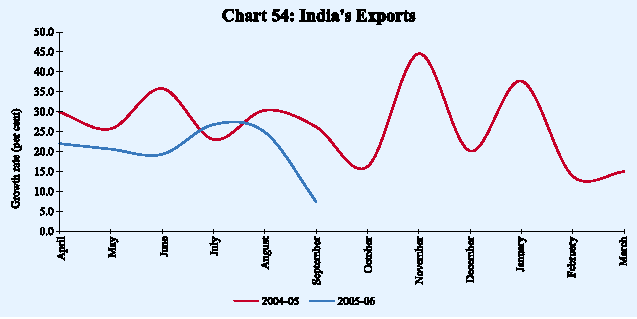
Export growth has been broad-based (Table 42). Exports of primary products were led by iron ore, reflecting increased global demand for metals. Among agricultural commodities, rice, coffee, raw cotton and cashew recorded a substantial pick-up in the wake of strong demand while tea, wheat, tobacco, oil meal and sugar suffered sharp deceleration. Exports of marine products showed a turnaround to a positive growth trajectory during April-August 2005 due to a pick-up in demand from Japan. In the manufacturing segment, engineering goods
Table 42: Export of Principal Commodities
|
(Growth rate in per cent) |
|||
|
2004-05 |
2004-05 |
2005-06 |
|
|
April-August |
|||
|
1 |
2 |
3 |
4 |
|
Agricultural and Allied Products |
8.3 |
19.9 |
17.5 |
|
Ores and Minerals |
104.2 |
75.2 |
48.6 |
|
Leather and Manufacture |
7.4 |
19.7 |
6.0 |
|
Chemicals and Related Products |
25.9 |
28.8 |
21.8 |
|
Engineering Goods |
34.5 |
37.2 |
28.9 |
|
Gems and Jewellery |
29.9 |
36.0 |
23.9 |
|
Handicrafts |
-26.4 |
-13.0 |
9.6 |
|
Petroleum Products |
90.5 |
75.1 |
61.3 |
|
Total Exports |
26.2 |
32.0 |
25.0 |
(transport equipment, machinery and parts and iron and steel), gems and jewellery, and chemicals (dyes, intermediates and cosmetics and inorganic chemicals) remained the key drivers of export growth. In the textiles segment, the pick-up in readymade garments was driven by strong demand in major markets, i.e., the US and Europe, reflecting the positive impact on India’s textile industry in the post-MFA period. Exports of petroleum products recorded a growth of 61.3 per cent during April-August 2005 on top of 75.1 per cent a year ago, benefiting from elevated international oil prices and reflecting the competitive strength of India’s petroleum refinery sector.
Latin America emerged as the fastest growing region for India’s exports during April-August 2005, followed by Africa, East Asia and Europe. Singapore, China, Korea, Hong Kong, South Africa, the Netherlands, France and the UK were the major markets for India’s exports (Chart 55).
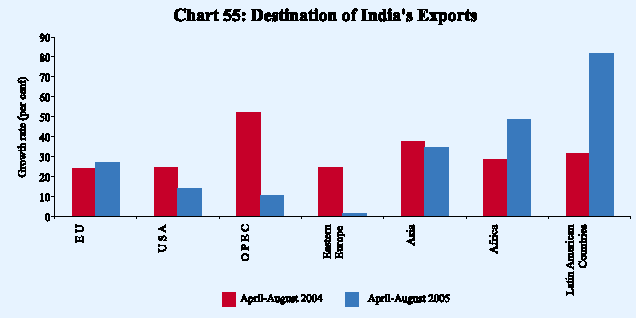
Imports maintained the tempo of high growth, driven by both oil and non-oil imports, in an environment of buoyant economy. The rise in petroleum, oil and lubricants (POL) imports (42.9 per cent) in April-September 2005 was due to a sharp increase in international crude oil prices. The average crude oil price (Indian basket) touched the level of US $ 59.3 per barrel in September 2005, recording a rise of 52.6 per cent over the previous year (Chart 56). In volume terms, oil imports declined by 0.8 per cent during April-August 2005 (as against an increase of 12.7 per cent a year ago) even as indigenous production of crude oil declined by 6.7 per cent. Domestic consumption of petroleum products registered a decline of 2.9 per cent during April-July 2005.
Non-oil imports maintained a high growth (28.8 per cent) during April-September 2005 (29.8 per cent a year ago) in tune with the acceleration in industrial activity (Chart 57). Capital goods posting a growth of 33.5 per cent during April-August 2005 were the key drivers of non-oil imports. The expansion
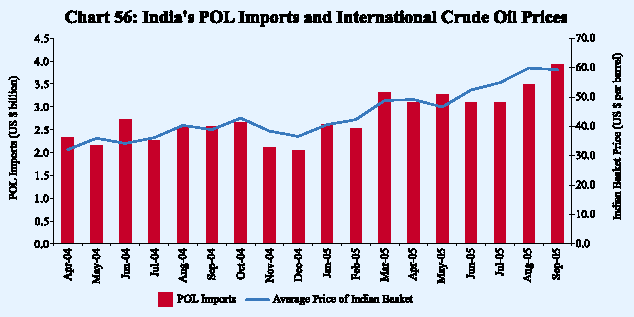
of capital goods imports, accompanied by a strong growth of domestic production of capital goods, reflects a build-up in capacity of the industrial sector.
Among other major items, gold and silver imports maintained strong growth in April-August 2005 (Table 43). Imports of mainly export related items registered strong growth in April-August 2005 due to pearls, precious stones and semiprecious stones (38.6 per cent). Among bulk goods, fertiliser and non-ferrous metals registered a steep rise while edible oil and pulses recorded decline in April-August 2005.
During April-August 2005, China emerged as the largest source of India’s imports, followed by Switzerland, the US, Belgium, UAE, Germany and Australia.
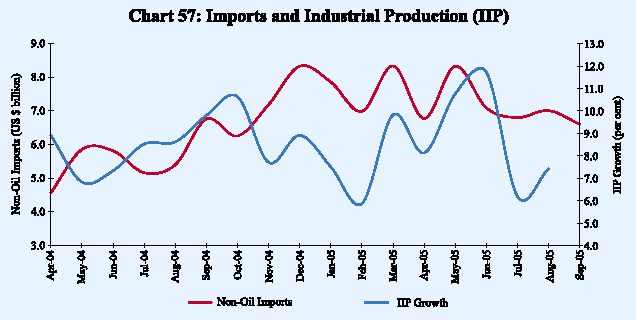
Table 43: Import of Principal Commodities
|
(Growth rate in per cent) |
|||
|
Item |
2004-05 |
2004-05 |
2005-06 |
|
April-August |
|||
|
1 |
2 |
3 |
4 |
|
Petroleum and Products |
45.1 |
58.4 |
40.8 |
|
Edible Oil |
-4.6 |
-14.3 |
-15.2 |
|
Non-Ferrous Metals |
33.0 |
41.1 |
37.4 |
|
Metalliferous Ores and Metal Scraps |
84.8 |
72.2 |
51.4 |
|
Iron and Steel |
72.3 |
74.5 |
109.9 |
|
Capital Goods |
33.8 |
29.5 |
33.5 |
|
Pearls, Precious and Semi Precious Stones |
32.2 |
22.8 |
38.6 |
|
Textile Yarn Fabric etc. |
19.9 |
12.8 |
37.0 |
|
Chemicals |
34.2 |
31.5 |
27.9 |
|
Gold and Silver |
59.6 |
32.7 |
52.0 |
|
Total Imports |
37.0 |
37.1 |
39.4 |
Trade deficit, based on DGCI&S data, surged by 71.0 per cent to US $ 20.3 billion during April-September 2005 (Table 44). The surge in non-oil imports, which increased by US $ 9.5 billion during April-September 2005, was the major factor underlying the expansion of trade deficit. During April-August 2005, the non-oil trade balance showed a deficit of US $ 4.8 billion as compared with a negligible deficit a year ago.
Table 44: India's Merchandise Trade
|
(US $ billion) |
||||
|
Item |
2004-05 |
2004-05 |
2005-06 |
|
|
April-September |
||||
|
1 |
2 |
3 |
4 |
|
|
Exports |
80.5 |
35.9 |
43.2 |
|
|
(26.2) |
(30.8) |
(20.5) |
||
|
Imports |
109.2 |
47.7 |
63.6 |
|
|
(39.7) |
(37.3) |
(33.1) |
||
|
Oil |
29.8 |
14.6 |
20.8 |
|
|
(45.1) |
(58.2) |
(42.9) |
||
|
Non-Oil |
79.3 |
33.2 |
42.7 |
|
|
(37.8) |
(29.8) |
(28.8) |
||
|
Trade Balance |
- 28.6 |
-11.9 |
-20.3 |
|
|
Note :Figures in parentheses show percentage change over |
||||
Current Account
Net surplus under the invisibles account continued to remain sizeable during April-June 2005 (Table 45). Gross invisible receipts remained buoyant (45.5 per cent growth), reflecting the underlying dynamism in travel earnings, sustained pace of export of software and other business and professional services and stable remittances from overseas Indians. Software exports remained on the high growth trajectory during April-June 2005. Private transfers, comprising remittances from
Table 45: Invisibles Account (Net)
|
(US $ million) |
||||||
|
Item |
2004-05 |
2004-05 |
2005-06 |
|||
|
(April- |
(April- |
|||||
|
Apr.-Jun. |
July-Sept. |
Oct.-Dec |
Jan.-Mar. |
|||
|
March) |
June) |
|||||
|
1 |
2 |
3 |
4 |
5 |
6 |
7 |
|
Travel |
-497 |
-335 |
-284 |
10 |
112 |
-560 |
|
Transportation |
509 |
385 |
-4 |
85 |
43 |
-18 |
|
Insurance |
294 |
12 |
57 |
111 |
114 |
44 |
|
Govt. not included elsewhere |
142 |
95 |
10 |
40 |
-3 |
-5 |
|
Software |
16,626 |
3,732 |
3,882 |
4,183 |
4,829 |
5,036 |
|
Other Services |
-2,444 |
-640 |
-1,651 |
-1,784 |
1,629 |
-217 |
|
Transfers |
21,048 |
5,959 |
4,481 |
4,592 |
6,016 |
6,235 |
|
Income |
-3,979 |
-644 |
-1,353 |
-933 |
-1,049 |
-907 |
|
Investment Income |
-2,848 |
-420 |
-1,097 |
-594 |
-737 |
-576 |
|
Compensation of |
||||||
|
Employees |
-1,131 |
-224 |
-256 |
-339 |
-312 |
-331 |
|
Total |
31,699 |
8,564 |
5,138 |
6,304 |
11,691 |
9,608 |
Indians working abroad, contributed about 23 per cent of gross invisible receipts. Invisibles payments surged (75 per cent) on account of growth in outbound tourist traffic, transportation and insurance payments associated with merchandise trade and rising import demand for business services such as business and management consultancy, engineering, technical and distribution services. On the whole, net invisible surplus during April-June 2005 was around US $ 1 billion higher than a year ago.
The net invisible surplus, however, fell short of the merchandise trade deficit which, on payments basis, nearly trebled to US $ 15.8 billion from the position a year ago in view of the large expansion in imports – both oil and especially, non-oil. Net invisible surplus thus could finance only 61 per cent of the trade deficit and the current account balance recorded a deficit of US $ 6.2 billion - a turnaround of US $ 9.6 billion from the position a year ago (Table 46).
Table 46: India’s Balance of Payments
|
(US $ million) |
|||||||
|
Item |
2004-05 |
2004-05 |
2005-06 |
||||
|
(April- |
(April- |
||||||
|
Apr.-Jun. |
July-Sept. |
Oct.-Dec |
Jan.-Mar. |
||||
|
March) |
June) |
||||||
|
1 |
2 |
3 |
4 |
5 |
6 |
7 |
|
|
Exports |
80,831 |
17,840 |
18,875 |
20,888 |
23,228 |
21,754 |
|
|
Imports |
1,18,961 |
23,014 |
28,514 |
32,673 |
34,760 |
37,563 |
|
|
Trade Balance |
-38,130 |
-5,174 |
-9,639 |
-11,785 |
-11,532 |
-15,809 |
|
|
Invisibles, net |
31,699 |
8,564 |
5,138 |
6,304 |
11,691 |
9,608 |
|
|
Gross Receipts |
77500 |
18209 |
15721 |
18,665 |
24,903 |
26,496 |
|
|
Gross Payments |
45801 |
9645 |
10583 |
12,361 |
13,212 |
16.888 |
|
|
Current Account |
-6,431 |
3,390 |
-4,501 |
-5,481 |
159 |
-6,201 |
|
|
Capital Account* |
32,590 |
4,180 |
3,867 |
12,075 |
12,470 |
7,448 |
|
|
Change in Reserves # |
-26,159 |
-7,570 |
634 |
-6,594 |
-12,629 |
-1,247 |
|
|
(-Indicates increase) |
|||||||
|
*: Includes errors and omissions. |
|||||||
Capital Flows
Capital flows to India remained strong during April-August of 2005-06, led by foreign investment flows. Foreign direct investment (FDI) inflows into India during April-August 2005 were 18 per cent higher than in the corresponding period of 2004, buoyed up by the pick-up in activity and positive investment climate. Industry-wise, FDI inflows were concentrated in cement, software supply services, food processing, textile, construction and financial services. Mauritius, US and UK continued to remain the dominant sources of FDI to India.
Portfolio investment flows witnessed a sharp turnaround during April-August, 2005 from the position a year ago. After remaining subdued during April-May 2005, Foreign Institutional Investors (FIIs) made large purchases in the Indian stock markets in the subsequent three months resulting in inflow under portfolio investment of US $ 3.8 billion during April-August 2005. The number of FIIs registered with the SEBI increased from 685 at end-March 2005 to 764 by end-August 2005 with the registration of FIIs from Australia, Austria, Canada, Denmark, Ireland, Italy, Sweden, Korea, Japan and Taiwan, providing a diverse FII base for investment in India. Portfolio flows through the issuances of American depository receipts (ADRs)/global depository receipts (GDRs) were higher during April-August 2005 as booming stocks offered corporates the opportunity to issue equities abroad.
Notwithstanding some firming up of international interest rates, demand for external commercial borrowings (ECBs) remained steady during April-June 2005 in consonance with the acceleration in industrial activity. Indian corporates indicated a preference for foreign currency convertible bonds (FCCBs) as these bond issuances are attractive due to lower spreads and conversion reduces the debt-servicing burden. Short-term trade credits, however, witnessed outflows as oil companies increased their recourse to domestic financing. As against net outflows during April-June 2004, Non-Resident Indian deposit accounts recorded net inflows of small magnitude during April-June 2005, primarily on account of inflows under the Non-Resident (External) Rupee Account [NR(E)RA] scheme (Table 47).
Table 47: Capital Flows
|
(US $ million) |
|||
|
Components |
Period |
2004-05 |
2005-06 |
|
1 |
2 |
3 |
4 |
|
Foreign Direct Investment into India |
April-August |
2,186 |
2,573 |
|
Portfolio Investment into India |
April-August |
98 |
3,796 |
|
FIIs |
April-August |
-72 |
3,219 |
|
ADRs/GDRs |
April-August |
170 |
568 |
|
External Assistance (Net) |
April-June |
36 |
204 |
|
External Commercial Borrowings (Net) |
|||
|
(Medium and long-term) |
April-June |
1,075 |
924 |
|
Short-term Trade Credits (Net) |
April-June |
1,775 |
-230 |
|
NRI Deposits (Net) |
April-June |
-786 |
211 |
Foreign Exchange Reserves
During the first quarter of 2005-06, the current account deficit was more than offset by surplus in the capital account, resulting in an accretion to the foreign exchange reserves of the order of US $ 1.2 billion on a balance of payments basis (i.e., excluding valuation effects).
India’s foreign exchange reserves stood at US $ 143.4 billion as on October 14, 2005, registering an increase of US $ 1.9 billion over end-March 2005 level. At this level, India held the fifth largest stock of reserves among the emerging market economies and the sixth largest in the world. The overall approach to the management of India’s foreign exchange reserves in recent years reflects the changing composition of the balance of payments and the ‘liquidity risks’ associated with different types of flows and other requirements. Taking these factors into account, India’s foreign exchange reserves continued to be at a comfortable level and consistent with the rate of growth, the share of external sector in the economy and the size of risk-adjusted capital flows.
External Debt
India’s total external debt was placed at US $ 122.1 billion at end-June 2005. At this level, the external debt stock declined by US $ 1.3 billion over the end-March 2005 level primarily reflecting the valuation effects of appreciation of the US dollar vis-à-vis other major international currencies. Component-wise, the reduction in external debt stock was mainly on account of a decline in multilateral and bilateral debt (Chart 58).
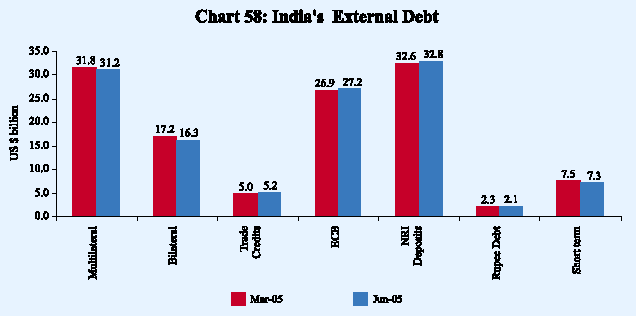
Table 48: Indicators of Debt Sustainability
|
(Per cent) |
||
|
Indicator |
March 2005 |
June 2005 |
|
1 |
2 |
3 |
|
Concessional debt/Total debt |
33.5 |
32.6 |
|
Short-term/Total debt |
6.1 |
6.0 |
|
Short-term debt/Reserves |
5.3 |
5.3 |
|
Reserves/ Total debt |
114.7 |
113.3 |
Over the years, there has been a perceptible improvement in external debt indicators reflecting the growing sustainability of external debt of India. This trend continued in April-June 2005 quarter also (Table 48). The ratio of short-term to total debt posted a marginal decline. The ratio of short-term debt to foreign exchange reserves remained stable. India’s foreign exchange reserves exceeded the external debt by US $ 16.2 billion providing a cover of 113.3 per cent to the external debt stock at the end of June 2005. The share of concessional debt in total external debt continued its declining trend reflecting a gradual surge in non-concessional private debt. Nonetheless, the concessional debt continues to be a significant proportion of the total external debt, especially by international standards.
International Investment Position
India’s international investment position improved further during 2004-05 as the increase (US $ 32.2 billion) in its external assets during the year outpaced that in external liabilities (US $ 26.0 billion). The increase in assets was mainly on account of reserve assets, reflecting the large overall surplus in the balance of payments. The expansion in external liabilities during 2004-05 was led by portfolio investment (mainly, FII inflows) followed by loans and direct investment. Consequently, India’s net external liabilities continued their downward trajectory during the year. At end-March 2005, the ratio of India’s net external liabilities to GDP at 6.3 per cent was one-half of the position two years ago (Table 49).
Table 49: International Investment Position of India
|
(US $ billion) |
||||||
|
Period |
March 2002 |
March 2003 |
March 2004 |
March 2005 |
||
|
1 |
2 |
3 |
4 |
5 |
||
|
A. Assets |
73.6 |
95.6 |
137.1 |
169.3 |
||
|
(17.2) |
(20.2) |
(23.6) |
(26.2) |
|||
|
1. |
Direct Investment |
4.0 |
5.8 |
7.1 |
9.6 |
|
|
2. |
Portfolio Investment |
0.7 |
0.8 |
0.8 |
0.8 |
|
|
2.1 |
Equity Securities |
0.3 |
0.4 |
0.4 |
0.4 |
|
|
2.2 |
Debt Securities |
0.3 |
0.4 |
0.4 |
0.4 |
|
|
3. |
Other Investment |
14.2 |
12.9 |
16.3 |
17.4 |
|
|
3.1 |
Trade Credits |
0.8 |
1.1 |
1.9 |
3.9 |
|
|
3.2 |
Loans |
2.2 |
1.4 |
1.7 |
1.8 |
|
|
3.3 |
Currency and Deposits |
8.8 |
7.5 |
9.6 |
8.3 |
|
|
3.4 |
Other Assets |
2.5 |
2.9 |
3.1 |
3.3 |
|
|
4. |
Reserve Assets |
54.7 |
76.1 |
113.0 |
141.5 |
|
|
(12.8) |
(16.1) |
(19.5) |
(21.9) |
|||
|
B. Liabilities |
142.7 |
156.0 |
184.1 |
210.1 |
||
|
(33.3) |
(32.9) |
(31.8) |
(32.5) |
|||
|
1. |
Direct Investment |
25.4 |
31.2 |
39.1 |
44.5 |
|
|
(5.9) |
(6.6) |
(6.7) |
(6.9) |
|||
|
2. |
Portfolio Investment |
31.5 |
32.4 |
43.7 |
55.5 |
|
|
(7.4) |
(6.8) |
(7.5) |
(8.6) |
|||
|
2.1 |
Equity Securities |
18.6 |
20.1 |
34.0 |
42.8 |
|
|
2.2 |
Debt securities |
12.9 |
12.3 |
9.8 |
12.7 |
|
|
3. |
Other Investment |
85.8 |
92.4 |
101.3 |
110.2 |
|
|
(20.0) |
(19.5) |
(17.5) |
(17.0) |
|||
|
3.1 |
Trade Credits |
3.8 |
4.8 |
6.3 |
9.6 |
|
|
3.2 |
Loans |
62.7 |
61.1 |
61.9 |
65.9 |
|
|
3.3 |
Currency and Deposits |
18.5 |
25.6 |
32.2 |
33.5 |
|
|
3.4 |
Other Liabilities |
0.7 |
0.9 |
0.9 |
1.2 |
|
|
C. Net Position (A-B) |
-69.1 |
-60.4 |
-47.0 |
-40.9 |
||
|
(-16.1) |
(-12.7) |
(-8.1) |
(-6.3) |
|||
|
Note: Figures in parenthesis are percentages to GDP. |
||||||






















